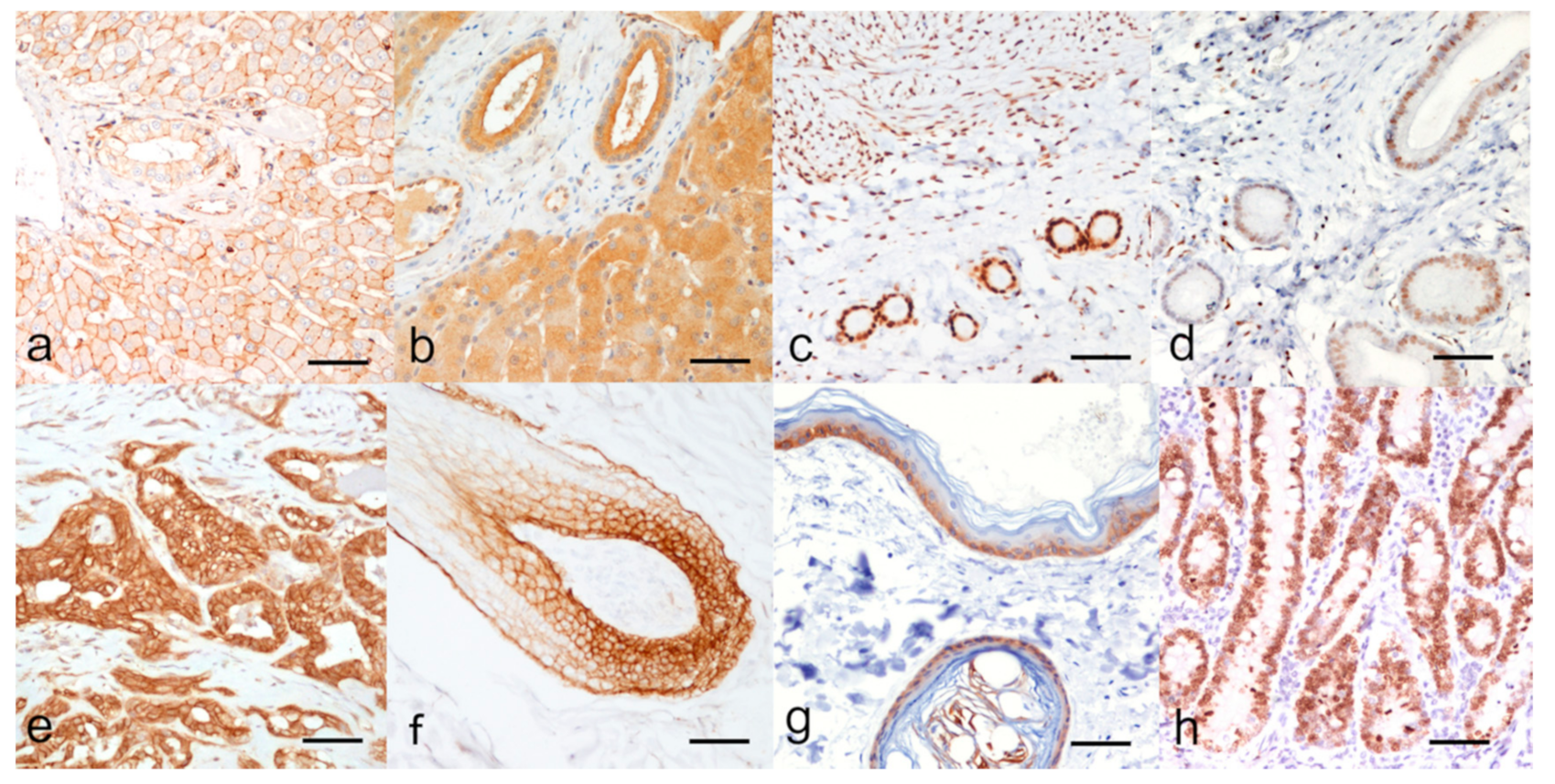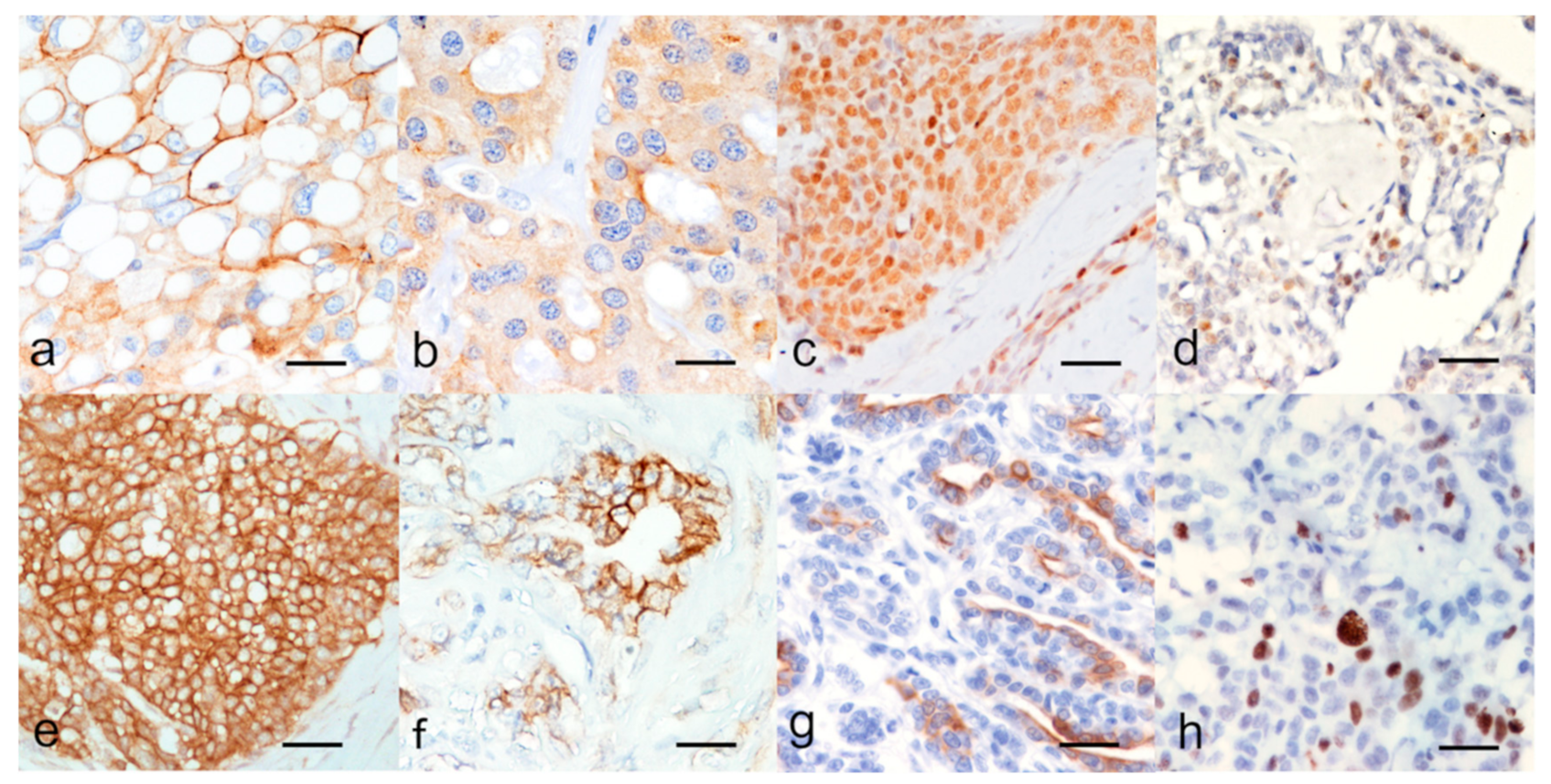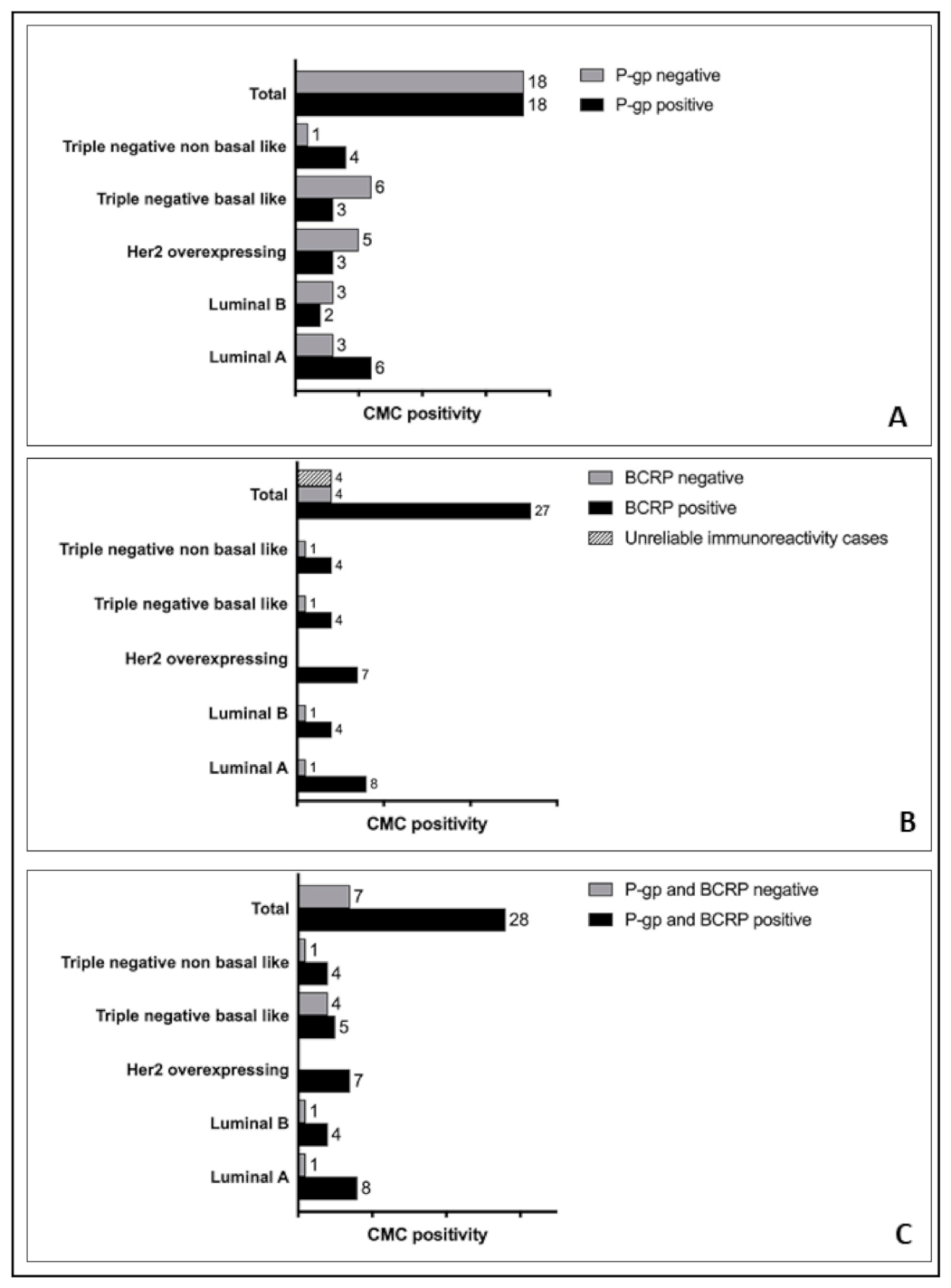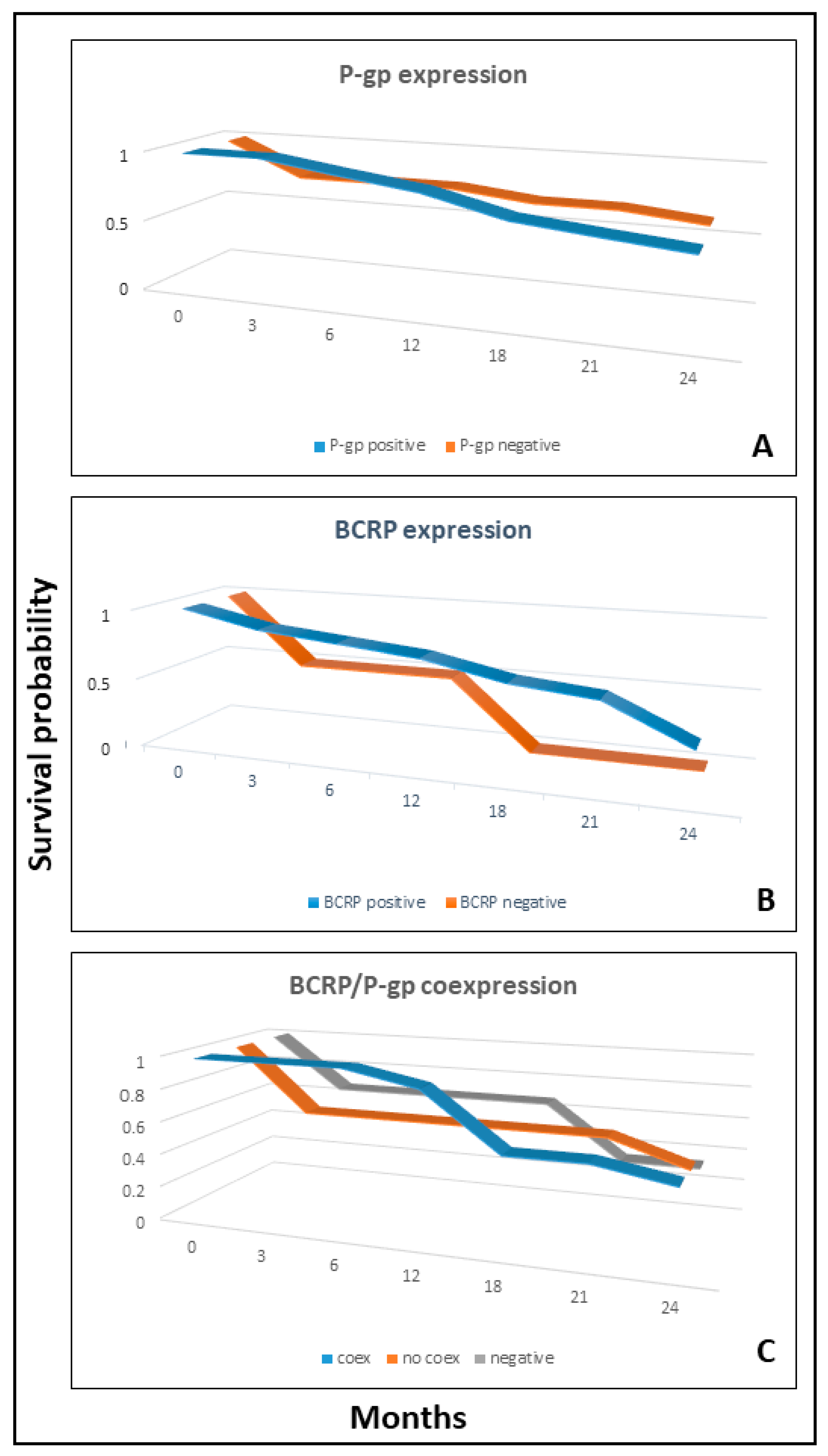High Intrinsic Expression of P-glycoprotein and Breast Cancer Resistance Protein in Canine Mammary Carcinomas Regardless of Immunophenotype and Outcome
Abstract
Simple Summary
Abstract
1. Introduction
2. Materials and Methods
2.1. Sample Selection, History and Histological Analysis
2.2. Immunohistochemistry
- Luminal A: HER2 negative (HER2 0, 1+ or 2+); ER and/or PR positive; Ki67 < 33%.
- Luminal B: HER2 negative (HER2 0, 1+ or 2+); ER and/or PR positive; Ki67 ≥ 33%.
- HER2-overexpressing: HER2 positive (HER2 3+).
- Triple-negative basal-like: HER2 negative (HER2 0, 1+ or 2+); ER and PR negative; EGFR and/or CK5/6 positive.
- Triple-negative non-basal-like: HER2 negative (HER2 0, 1+ or 2+); ER and PR negative; EGFR and CK5/6 negative.
2.3. Statistical Analysis
3. Results
3.1. Animal Data and Histopathological Characteristics of Tumors
3.2. Immunohistochemistry
- Luminal A: 9 carcinomas (24.3%);
- Luminal B: 5 carcinomas (13.5%);
- HER2-overexpressing: 9 carcinomas (24.3%);
- Triple-negative basal-like: 9 carcinomas (24.3%);
- Triple-negative non-basal-like: 5 carcinomas (13.5%).
4. Discussion
5. Conclusions
Supplementary Materials
Author Contributions
Funding
Institutional Review Board Statement
Data Availability Statement
Conflicts of Interest
Abbreviations
| ABC | Adenosine Triphosphate-binding cassette |
| CK 5/6 | Basal cytokeratins 5/6 |
| CMC | Canine mammary carcinoma |
| CTR | control |
| EGFR1 | Epidermal Growth Factor Receptor type 1 |
| ERα | Estrogen Receptor alpha |
| HER2 | Human Epidermal Growth Factor Receptor type 2 |
| IHC | immunohistochemistry |
| MDR | Multidrug resistance |
| PR | Progesterone Receptor |
References
- Amawi, H.; Sim, H.-M.; Tiwari, A.K.; Ambudkar, S.V.; Shukla, S. ABC Transporter-Mediated Multidrug-Resistant Cancer. Adv. Exp. Med. Biol. 2019, 1141, 549–580. [Google Scholar] [CrossRef]
- Briz, O.; Perez-Silva, L.; Al-Abdulla, R.; Abete, L.; Reviejo, M.; Romero, M.R.; Marin, J.J.G. What “The Cancer Genome Atlas” Database Tells Us about the Role of ATP-Binding Cassette (ABC) Proteins in Chemoresistance to Anticancer Drugs. Expert Opin. Drug Metab. Toxicol. 2019, 15, 577–593. [Google Scholar] [CrossRef]
- Zheng, H.C. The Molecular Mechanisms of Chemoresistance in Cancers. Oncotarget 2017, 8, 59950–59964. [Google Scholar] [CrossRef]
- Chung, H.C.; Rha, S.Y.; Kim, J.H.; Roh, J.K.; Min, J.S.; Lee, K.S.; Kim, B.S.; Lee, K.B. P-Glycoprotein: The Intermediate End Point of Drug Response to Induction Chemotherapy in Locally Advanced Breast Cancer. Breast Cancer Res. Treat. 1997, 42, 65–72. [Google Scholar] [CrossRef]
- Nedeljković, M.; Damjanović, A. Mechanisms of Chemotherapy Resistance in Triple-Negative Breast Cancer—How We Can Rise to the Challenge. Cells 2019, 8, 957. [Google Scholar] [CrossRef] [PubMed]
- Yamada, A.; Ishikawa, T.; Ota, I.; Kimura, M.; Shimizu, D.; Tanabe, M.; Chishima, T.; Sasaki, T.; Ichikawa, Y.; Morita, S.; et al. High Expression of ATP-Binding Cassette Transporter ABCC11 in Breast Tumors Is Associated with Aggressive Subtypes and Low Disease-Free Survival. Breast Cancer Res. Treat. 2013, 137, 773–782. [Google Scholar] [CrossRef]
- Clarke, R.; Leonessa, F.; Trock, B. Multidrug Resistance/P-Glycoprotein and Breast Cancer: Review and Meta-Analysis. Semin. Oncol. 2005, 32, 9–15. [Google Scholar] [CrossRef]
- Gameiro, M.; Silva, R.; Rocha-Pereira, C.; Carmo, H.; Carvalho, F.; de L. Bastos, M.; Remião, F. Cellular Models and In Vitro Assays for the Screening of Modulators of P-Gp, MRP1 and BCRP. Mol. Basel Switz. 2017, 22, 600. [Google Scholar] [CrossRef]
- Ginn, P.E. Immunohistochemical Detection of P-Glycoprotein in Formalin-Fixed and Paraffin-Embedded Normal and Neoplastic Canine Tissues. Vet. Pathol. 1996, 33, 533–541. [Google Scholar] [CrossRef]
- Honscha, K.U.; Schirmer, A.; Reischauer, A.; Schoon, H.-A.; Einspanier, A.; Gäbel, G. Expression of ABC-Transport Proteins in Canine Mammary Cancer: Consequences for Chemotherapy. Reprod. Domest. Anim. Zuchthyg. 2009, 44 (Suppl. 2), 218–223. [Google Scholar] [CrossRef]
- Kim, N.-H.; Hwang, Y.-H.; Im, K.-S.; Kim, J.-H.; Chon, S.-K.; Kim, H.-Y.; Sur, J.-H. P-Glycoprotein Expression in Canine Mammary Gland Tumours Related with Myoepithelial Cells. Res. Vet. Sci. 2012, 93, 1346–1352. [Google Scholar] [CrossRef]
- Koltai, Z.; Vajdovich, P. Expression of Multidrug Resistance Membrane Transporter (Pgp) and P53 Protein in Canine Mammary Tumours. Acta Vet. Hung. 2014, 62, 194–204. [Google Scholar] [CrossRef] [PubMed]
- Król, M.; Pawłowski, K.M.; Majchrzak, K.; Mucha, J.; Motyl, T. Canine Mammary Carcinoma Cell Line Are Resistant to Chemosensitizers: Verapamil and Cyclosporin, A. Pol. J. Vet. Sci. 2014, 17, 9–17. [Google Scholar] [CrossRef]
- Levi, M.; Brunetti, B.; Sarli, G.; Benazzi, C. Immunohistochemical Expression of P-Glycoprotein and Breast Cancer Resistance Protein in Canine Mammary Hyperplasia, Neoplasia and Supporting Stroma. J. Comp. Pathol. 2016, 155, 277–285. [Google Scholar] [CrossRef] [PubMed]
- Levi, M.; Peña, L.; Alonso-Díez, A.; Brunetti, B.; Muscatello, L.V.; Benazzi, C.; Pérez-Alenza, M.D.; Sarli, G. P-Glycoprotein and Breast Cancer Resistance Protein in Canine Inflammatory and Noninflammatory Grade III Mammary Carcinomas. Vet. Pathol. 2019, 56, 840–847. [Google Scholar] [CrossRef]
- Nowak, M.; Madej, J.A.; Dziegiel, P. Expression of Breast Cancer Resistance Protein (BCRP-1) in Canine Mammary Adenocarcinomas and Adenomas. In Vivo 2009, 23, 705–709. [Google Scholar]
- Pawłowski, K.M.; Mucha, J.; Majchrzak, K.; Motyl, T.; Król, M. Expression and Role of PGP, BCRP, MRP1 and MRP3 in Multidrug Resistance of Canine Mammary Cancer Cells. BMC Vet. Res. 2013, 9, 119. [Google Scholar] [CrossRef] [PubMed]
- Petterino, C.; Rossetti, E.; Bertoncello, D.; Martini, M.; Zappulli, V.; Bargelloni, L.; Castagnaro, M. Immunohistochemical Detection of P-Glycoprotein (Clone C494) in Canine Mammary Gland Tumours. J. Vet. Med. A Physiol. Pathol. Clin. Med. 2006, 53, 174–178. [Google Scholar] [CrossRef]
- Zandvliet, M.; Teske, E. Mechanisms of Drug Resistance in Veterinary Oncology—A Review with an Emphasis on Canine Lymphoma. Vet. Sci. 2015, 2, 150–184. [Google Scholar] [CrossRef] [PubMed]
- Virkel, G.; Ballent, M.; Lanusse, C.; Lifschitz, A. Role of ABC Transporters in Veterinary Medicine: Pharmaco- Toxicological Implications. Curr. Med. Chem. 2019, 26, 1251–1269. [Google Scholar] [CrossRef] [PubMed]
- Zappulli, V.; Peña, L.; Rasotto, R.; Goldschmidt, M.H.; Gama, A.; Scruggs, J.L. Surgical Pathology of Tumors of Domestic Animals Volume 2: Volume 2: Mammary Tumors: Mammary Tumors; Davis Thompson Foundation: Gurnee, IL, USA, 2019; ISBN 978-1-73374-911-4. [Google Scholar]
- Nielsen, T.O.; Hsu, F.D.; Jensen, K.; Cheang, M.; Karaca, G.; Hu, Z.; Hernandez-Boussard, T.; Livasy, C.; Cowan, D.; Dressler, L.; et al. Immunohistochemical and Clinical Characterization of the Basal-Like Subtype of Invasive Breast Carcinoma. Clin. Cancer Res. 2004, 10, 5367–5374. [Google Scholar] [CrossRef]
- Diestra, J.E.; Scheffer, G.L.; Català, I.; Maliepaard, M.; Schellens, J.H.M.; Scheper, R.J.; Germà-Lluch, J.R.; Izquierdo, M.A. Frequent Expression of the Multi-Drug Resistance-Associated Protein BCRP/MXR/ABCP/ABCG2 in Human Tumours Detected by the BXP-21 Monoclonal Antibody in Paraffin-Embedded Material. J. Pathol. 2002, 198, 213–219. [Google Scholar] [CrossRef]
- Allred, D.C.; Harvey, J.M.; Berardo, M.; Clark, G.M. Prognostic and Predictive Factors in Breast Cancer by Immunohistochemical Analysis. Mod. Pathol. Off. J. U. S. Can. Acad. Pathol. Inc. 1998, 11, 155–168. [Google Scholar]
- Peña, L.; Gama, A.; Goldschmidt, M.H.; Abadie, J.; Benazzi, C.; Castagnaro, M.; Díez, L.; Gärtner, F.; Hellmén, E.; Kiupel, M.; et al. Canine Mammary Tumors: A Review and Consensus of Standard Guidelines on Epithelial and Myoepithelial Phenotype Markers, HER2, and Hormone Receptor Assessment Using Immunohistochemistry. Vet. Pathol. 2014, 51, 127–145. [Google Scholar] [CrossRef]
- Nguyen, F.; Peña, L.; Ibisch, C.; Loussouarn, D.; Gama, A.; Rieder, N.; Belousov, A.; Campone, M.; Abadie, J. Canine Invasive Mammary Carcinomas as Models of Human Breast Cancer. Part 1: Natural History and Prognostic Factors. Breast Cancer Res. Treat. 2018, 167, 635–648. [Google Scholar] [CrossRef] [PubMed]
- Wolff, A.C.; Hammond, M.E.H.; Allison, K.H.; Harvey, B.E.; Mangu, P.B.; Bartlett, J.M.S.; Bilous, M.; Ellis, I.O.; Fitzgibbons, P.; Hanna, W.; et al. Human Epidermal Growth Factor Receptor 2 Testing in Breast Cancer: American Society of Clinical Oncology/College of American Pathologists Clinical Practice Guideline Focused Update. J. Clin. Oncol. 2018, 36, 2105–2122. [Google Scholar] [CrossRef]
- Abadie, J.; Nguyen, F.; Loussouarn, D.; Peña, L.; Gama, A.; Rieder, N.; Belousov, A.; Bemelmans, I.; Jaillardon, L.; Ibisch, C.; et al. Canine Invasive Mammary Carcinomas as Models of Human Breast Cancer. Part 2: Immunophenotypes and Prognostic Significance. Breast Cancer Res. Treat. 2018, 167, 459–468. [Google Scholar] [CrossRef]
- Blows, F.M.; Driver, K.E.; Schmidt, M.K.; Broeks, A.; van Leeuwen, F.E.; Wesseling, J.; Cheang, M.C.; Gelmon, K.; Nielsen, T.O.; Blomqvist, C.; et al. Subtyping of Breast Cancer by Immunohistochemistry to Investigate a Relationship between Subtype and Short and Long Term Survival: A Collaborative Analysis of Data for 10,159 Cases from 12 Studies. PLOS Med. 2010, 7, e1000279. [Google Scholar] [CrossRef] [PubMed]
- Perou, C.M.; Sørlie, T.; Eisen, M.B.; van de Rijn, M.; Jeffrey, S.S.; Rees, C.A.; Pollack, J.R.; Ross, D.T.; Johnsen, H.; Akslen, L.A.; et al. Molecular Portraits of Human Breast Tumours. Nature 2000, 406, 747–752. [Google Scholar] [CrossRef]
- Ross, J.S.; Slodkowska, E.A.; Symmans, W.F.; Pusztai, L.; Ravdin, P.M.; Hortobagyi, G.N. The HER-2 Receptor and Breast Cancer: Ten Years of Targeted Anti–HER-2 Therapy and Personalized Medicine. Oncologist 2009, 14, 320–368. [Google Scholar] [CrossRef]
- Bianchini, G.; Balko, J.M.; Mayer, I.A.; Sanders, M.E.; Gianni, L. Triple-Negative Breast Cancer: Challenges and Opportunities of a Heterogeneous Disease. Nat. Rev. Clin. Oncol. 2016, 13, 674–690. [Google Scholar] [CrossRef] [PubMed]
- Martin, H.L.; Smith, L.; Tomlinson, D.C. Multidrug-Resistant Breast Cancer: Current Perspectives. Breast Cancer Dove Med. Press 2014, 6, 1–13. [Google Scholar] [CrossRef] [PubMed]
- Gama, A.; Alves, A.; Schmitt, F. Identification of Molecular Phenotypes in Canine Mammary Carcinomas with Clinical Implications: Application of the Human Classification. Virchows Arch. Int. J. Pathol. 2008, 453, 123–132. [Google Scholar] [CrossRef]
- Sassi, F.; Benazzi, C.; Castellani, G.; Sarli, G. Molecular-Based Tumour Subtypes of Canine Mammary Carcinomas Assessed by Immunohistochemistry. BMC Vet. Res. 2010, 6, 5. [Google Scholar] [CrossRef]
- Queiroga, F.L.; Raposo, T.; Carvalho, M.I.; Prada, J.; Pires, I. Canine Mammary Tumours as a Model to Study Human Breast Cancer: Most Recent Findings. In Vivo 2011, 25, 455–465. [Google Scholar]
- Beha, G.; Brunetti, B.; Asproni, P.; Muscatello, L.V.; Millanta, F.; Poli, A.; Sarli, G.; Benazzi, C. Molecular Portrait-Based Correlation between Primary Canine Mammary Tumor and Its Lymph Node Metastasis: Possible Prognostic-Predictive Models and/or Stronghold for Specific Treatments? BMC Vet. Res. 2012, 8, 219. [Google Scholar] [CrossRef] [PubMed]
- Beha, G.; Muscatello, L.V.; Brunetti, B.; Asproni, P.; Millanta, F.; Poli, A.; Benazzi, C.; Sarli, G. Molecular Phenotype of Primary Mammary Tumours and Distant Metastases in Female Dogs and Cats. J. Comp. Pathol. 2014, 150, 194–197. [Google Scholar] [CrossRef]
- Im, K.S.; Kim, N.H.; Lim, H.Y.; Kim, H.W.; Shin, J.I.; Sur, J.H. Analysis of a New Histological and Molecular-Based Classification of Canine Mammary Neoplasia. Vet. Pathol. 2014, 51, 549–559. [Google Scholar] [CrossRef] [PubMed]
- Goldschmidt, M.H.; Peña, L.; Zappulli, V. Tumors of the Mammary Gland. In Tumors in Domestic Animals, 5th ed.; Meuten, D.J., Ed.; John Wiley & Sons, Inc.: Ames, IA, USA, 2017; pp. 723–765. [Google Scholar]
- Brunetti, B.; Bacci, B.; Angeli, C.; Benazzi, C.; Muscatello, L.V. P53, ER, and Ki67 Expression in Canine Mammary Carcinomas and Correlation With Pathological Variables and Prognosis. Vet. Pathol. 2020. [Google Scholar] [CrossRef]
- Ressel, L.; Puleio, R.; Loria, G.R.; Vannozzi, I.; Millanta, F.; Caracappa, S.; Poli, A. HER-2 Expression in Canine Morphologically Normal, Hyperplastic and Neoplastic Mammary Tissues and Its Correlation with the Clinical Outcome. Res. Vet. Sci. 2013, 94, 299–305. [Google Scholar] [CrossRef]
- Araújo, M.R.; Campos, L.C.; Damasceno, K.A.; Gamba, C.O.; Ferreira, E.; Cassali, G.D. HER-2, EGFR, Cox-2 and Ki67 Expression in Lymph Node Metastasis of Canine Mammary Carcinomas: Association with Clinical-Pathological Parameters and Overall Survival. Res. Vet. Sci. 2016, 106, 121–130. [Google Scholar] [CrossRef] [PubMed]
- Burrai, G.P.; Tanca, A.; De Miglio, M.R.; Abbondio, M.; Pisanu, S.; Polinas, M.; Pirino, S.; Mohammed, S.I.; Uzzau, S.; Addis, M.F.; et al. Investigation of HER2 Expression in Canine Mammary Tumors by Antibody-Based, Transcriptomic and Mass Spectrometry Analysis: Is the Dog a Suitable Animal Model for Human Breast Cancer? Tumour Biol. J. Int. Soc. Oncodev. Biol. Med. 2015, 36, 9083–9091. [Google Scholar] [CrossRef] [PubMed]
- Omran, O.M. The Prognostic Value of Breast Cancer Resistance Protein (BCRB/ABCG2) Expression in Breast Carcinomas. J. Environ. Pathol. Toxicol. Oncol. Off. Organ Int. Soc. Environ. Toxicol. Cancer 2012, 31, 367–376. [Google Scholar] [CrossRef] [PubMed]
- Xiang, L.; Su, P.; Xia, S.; Liu, Z.; Wang, Y.; Gao, P.; Zhou, G. ABCG2 Is Associated with HER-2 Expression, Lymph Node Metastasis and Clinical Stage in Breast Invasive Ductal Carcinoma. Diagn. Pathol. 2011, 6, 90. [Google Scholar] [CrossRef]
- Zhang, W.; Ding, W.; Chen, Y.; Feng, M.; Ouyang, Y.; Yu, Y.; He, Z. Up-Regulation of Breast Cancer Resistance Protein Plays a Role in HER2-Mediated Chemoresistance through PI3K/Akt and Nuclear Factor-Kappa B Signaling Pathways in MCF7 Breast Cancer Cells. Acta Biochim. Biophys. Sin. 2011, 43, 647–653. [Google Scholar] [CrossRef]
- Gilani, R.A.; Kazi, A.A.; Shah, P.; Schech, A.J.; Chumsri, S.; Sabnis, G.; Jaiswal, A.K.; Brodie, A.H. The Importance of HER2 Signaling in the Tumor-Initiating Cell Population in Aromatase Inhibitor-Resistant Breast Cancer. Breast Cancer Res. Treat. 2012, 135, 681–692. [Google Scholar] [CrossRef]
- Dean, M. ABC Transporters, Drug Resistance, and Cancer Stem Cells. J. Mammary Gland Biol. Neoplasia 2009, 14, 3–9. [Google Scholar] [CrossRef]
- Kuroda, H.; Ishida, F.; Nakai, M.; Ohnisi, K.; Itoyama, S. Basal Cytokeratin Expression in Relation to Biological Factors in Breast Cancer. Hum. Pathol. 2008, 39, 1744–1750. [Google Scholar] [CrossRef]
- Yang, G.; Xue, F.; Chen, X. Expression of MDR1 gene in cancer stem cells in breast cancer tissues of different molecular subtypes. Nan Fang Yi Ke Da Xue Xue Bao 2012, 32, 1636–1638. [Google Scholar]
- Pavelic, Z.P.; Reising, J.; Pavelic, L.; Kelley, D.J.; Stambrook, P.J.; Gluckman, J.L. Detection of P-Glycoprotein with Four Monoclonal Antibodies in Normal and Tumor Tissues. Arch. Otolaryngol. Head Neck Surg. 1993, 119, 753–757. [Google Scholar] [CrossRef]
- Maliepaard, M.; Scheffer, G.L.; Faneyte, I.F.; van Gastelen, M.A.; Pijnenborg, A.C.; Schinkel, A.H.; van De Vijver, M.J.; Scheper, R.J.; Schellens, J.H. Subcellular Localization and Distribution of the Breast Cancer Resistance Protein Transporter in Normal Human Tissues. Cancer Res. 2001, 61, 3458–3464. [Google Scholar] [PubMed]
- Gown, A.M. Current Issues in ER and HER2 Testing by IHC in Breast Cancer. Mod. Pathol. Off. J. U. S. Can. Acad. Pathol. Inc. 2008, 21, S8–S15. [Google Scholar] [CrossRef] [PubMed]
- Ramos-Vara, J.A. Technical Aspects of Immunohistochemistry. Vet. Pathol. 2005, 42, 405–426. [Google Scholar] [CrossRef] [PubMed]




| Marker | Type, Clone | Supplier | Dilution Primary ab/Incubation | Ag Retrieval | Positive External CTR | Positive Internal CTR |
|---|---|---|---|---|---|---|
| P-gp | Mouse monoclonal anti–P-gp/CD243 (C494) | GeneTex International, Irvine, California | 1:1500/ ON 4 °C | 10′ Citrate pH6 MW:750 W | Canine liver | Lymphovascular endothelium |
| BCRP | Mouse monoclonal anti-BCRP (BXP-21) | Merck, Darmstadt, Germany | 1:200/ ON 4 °C | 10′ Citrate pH6 MW:750 W | Canine liver | Lymphovascular endothelium |
| ER alpha | Polyclonal anti-ER alpha | Thermo Fisher Scientific, Göteborg, Sweden | 1:100/ ON 4 °C | 10′ Citrate pH6 MW:750 W | Canine myometrium | Canine mammary gland |
| PR | Mouse monoclonal anti-PR (Ab-1) | Clabiochem/Merck KGaA, Darmstadt, Germany | 1:50/ ON 4 °C | 10′ Citrate pH6 MW:750 W | Canine myometrium | Canine mammary gland |
| HER2 | Polyclonal anti-HER2 (A0485) | Dako, Glostrup, Denmark | 1:200/ ON 4 °C | 10′ Citrate pH6 MW:750 W | Canine mammary carcinoma HER2 score 3+ | / |
| EGFR | Mouse monoclonal anti-EGFR Ab-10 (111.6) | NeoMarkers, Freemont, California | 1:100/ ON 4 °C | 15′ 37 °C Protease XIV 0.05% in PBS pH 7.5 | Canine epidermis and hair follicles- basal layers | Canine epidermis and hair follicles- basal layers |
| CK5/6 | Mouse monoclonal anti-CK5/6 (D5/16B4) | Zymed, South San Francisco, California | 1:300/ ON 4 °C | 15′ EDTA pH8 MW:750 W | Canine mammary gland- myoepithelium | Canine mammary gland- myoepithelium |
| Ki67 | Mouse monoclonal anti-Ki67 (MIB-1) | Dako, Glostrup, Denmark | 1:600/ ON 4 °C | 20′ Citrate pH6 MW:750 W | Canine intestinal crypts | Hyperplastic canine mammary gland/hair follicles bulb |
| IHC Marker | Carcinomas n | % |
|---|---|---|
| P-gp total | 48 | |
| P-gp positive total (≥20% §) | 25 | 52 |
| P-gp (≥50% §) | 10 | 20.8 |
| P-gp (20–50% §) | 15 | 31.2 |
| P-gp negative (<10% §) | 23 | 48 |
| BCRP total | 47 | |
| BCRP positive total (≥10% §) | 35 | 74.5 |
| BCRP (≥50% §) | 18 | 38.3 |
| BCRP (10–50% §) | 17 | 36.2 |
| BCRP negative (<10% §) | 12 | 25.5 |
| ER total | 45 | |
| ER positive (≥10% §) | 21 | 46.6 |
| ER negative (<10% §) | 24 | 53.4 |
| PR total | 36 | |
| PR positive (≥10% §) | 3 | 8.4 |
| PR negative (<10% §) | 33 | 91.6 |
| HER2 total | 50 | |
| HER2 negative 0 | 6 | 12 |
| HER2 negative 1+ | 22 | 44 |
| HER2 negative 2+ | 13 | 26 |
| HER2 positive 3+ | 9 | 18 |
| EGFR total | 43 | |
| EGFR positive (≥10% §) | 25 | 58 |
| EGFR negative (<10% §) | 18 | 42 |
| CK5/6 total | 46 | |
| CK5/6 positive (≥10% §) | 22 | 48 |
| CK5/6 negative (<10% §) | 24 | 52 |
| Ki67 total | 46 | |
| Ki67 < 33% § | 30 | 65 |
| Ki67 ≥ 33% § | 16 | 35 |
| Correlation Analysis | R | p Value |
| Immunophenotype | ||
| P-gp positive CMCs | R = −0.0007 | p = 1 |
| BCRP positive CMCs | R = −0.296 | p = 0.084 |
| coexpression of P-gp and BCRP | R = −0.2998 | p = 0.228 |
| Ki67 > 33% | ||
| P-gp positive CMCs | R = −0.1552 | p = 0.315 |
| BCRP positive CMCs | R = −0.0564 | p = 0.7180 |
| coexpression of P-gp and BCRP | R = −0.0345 | p = 0.88 |
| Histologic grade | ||
| P-gp positive CMCs | R = −0.1753 | p = 0.26 |
| BCRP positive CMCs | R = 0.105 | p = 0.502 |
| coexpression of P-gp and BCRP | R = 0.0536 | p = 0.814 |
| Ki67 > 33% | R = 0.67 | p < 0.00001 |
Publisher’s Note: MDPI stays neutral with regard to jurisdictional claims in published maps and institutional affiliations. |
© 2021 by the authors. Licensee MDPI, Basel, Switzerland. This article is an open access article distributed under the terms and conditions of the Creative Commons Attribution (CC BY) license (http://creativecommons.org/licenses/by/4.0/).
Share and Cite
Levi, M.; Muscatello, L.V.; Brunetti, B.; Benazzi, C.; Parenti, F.; Gobbo, F.; Avallone, G.; Bacci, B.; Zambon, E.; Valenti, P.; et al. High Intrinsic Expression of P-glycoprotein and Breast Cancer Resistance Protein in Canine Mammary Carcinomas Regardless of Immunophenotype and Outcome. Animals 2021, 11, 658. https://doi.org/10.3390/ani11030658
Levi M, Muscatello LV, Brunetti B, Benazzi C, Parenti F, Gobbo F, Avallone G, Bacci B, Zambon E, Valenti P, et al. High Intrinsic Expression of P-glycoprotein and Breast Cancer Resistance Protein in Canine Mammary Carcinomas Regardless of Immunophenotype and Outcome. Animals. 2021; 11(3):658. https://doi.org/10.3390/ani11030658
Chicago/Turabian StyleLevi, Michela, Luisa Vera Muscatello, Barbara Brunetti, Cinzia Benazzi, Federico Parenti, Francesca Gobbo, Giancarlo Avallone, Barbara Bacci, Elisa Zambon, Paola Valenti, and et al. 2021. "High Intrinsic Expression of P-glycoprotein and Breast Cancer Resistance Protein in Canine Mammary Carcinomas Regardless of Immunophenotype and Outcome" Animals 11, no. 3: 658. https://doi.org/10.3390/ani11030658
APA StyleLevi, M., Muscatello, L. V., Brunetti, B., Benazzi, C., Parenti, F., Gobbo, F., Avallone, G., Bacci, B., Zambon, E., Valenti, P., & Sarli, G. (2021). High Intrinsic Expression of P-glycoprotein and Breast Cancer Resistance Protein in Canine Mammary Carcinomas Regardless of Immunophenotype and Outcome. Animals, 11(3), 658. https://doi.org/10.3390/ani11030658








